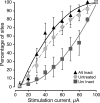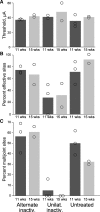Activity-dependent plasticity improves M1 motor representation and corticospinal tract connectivity
- PMID: 19091920
- PMCID: PMC2666405
- DOI: 10.1152/jn.91026.2008
Activity-dependent plasticity improves M1 motor representation and corticospinal tract connectivity
Abstract
Motor cortex (M1) activity between postnatal weeks 5 and 7 is essential for normal development of the corticospinal tract (CST) and visually guided movements. Unilateral reversible inactivation of M1, by intracortical muscimol infusion, during this period permanently impairs development of the normal dorsoventral distribution of CST terminations and visually guided motor skills. These impairments are abrogated if this M1 inactivation is followed by inactivation of the contralateral, initially active M1, from weeks 7 to 11 (termed alternate inactivation). This later period is when the M1 motor representation normally develops. The purpose of this study was to determine the effects of alternate inactivation on the motor representation of the initially inactivated M1. We used intracortical microstimulation to map the left M1 1 to 2 mo after the end of left M1 muscimol infusion. We compared representations in the unilateral inactivation and alternate inactivation groups. Alternate inactivation converted the sparse proximal M1 motor representation produced by unilateral inactivation to a complete and high-resolution proximal-distal representation. The motor map was restored by week 11, the same age that our present and prior studies demonstrated that alternate inactivation restored CST spinal connectivity. Thus M1 motor map developmental plasticity closely parallels plasticity of CST spinal terminations. After alternate inactivation reestablished CST connections and the motor map, an additional 3 wk was required for motor skill recovery. Since motor map recovery preceded behavioral recovery, our findings suggest that the representation is necessary for recovering motor skills, but additional time, or experience, is needed to learn to take advantage of the restored CST connections and motor map.
Figures






Similar articles
-
Motor Cortex Activity Organizes the Developing Rubrospinal System.J Neurosci. 2015 Sep 30;35(39):13363-74. doi: 10.1523/JNEUROSCI.1719-15.2015. J Neurosci. 2015. PMID: 26424884 Free PMC article.
-
Pyramidal tract stimulation restores normal corticospinal tract connections and visuomotor skill after early postnatal motor cortex activity blockade.J Neurosci. 2008 Jul 16;28(29):7426-34. doi: 10.1523/JNEUROSCI.1078-08.2008. J Neurosci. 2008. PMID: 18632946 Free PMC article.
-
Bilateral activity-dependent interactions in the developing corticospinal system.J Neurosci. 2007 Oct 10;27(41):11083-90. doi: 10.1523/JNEUROSCI.2814-07.2007. J Neurosci. 2007. PMID: 17928450 Free PMC article.
-
Activity- and use-dependent plasticity of the developing corticospinal system.Neurosci Biobehav Rev. 2007;31(8):1125-35. doi: 10.1016/j.neubiorev.2007.04.017. Epub 2007 May 17. Neurosci Biobehav Rev. 2007. PMID: 17599407 Free PMC article. Review.
-
Harnessing activity-dependent plasticity to repair the damaged corticospinal tract in an animal model of cerebral palsy.Dev Med Child Neurol. 2011 Sep;53 Suppl 4(Suppl 4):9-13. doi: 10.1111/j.1469-8749.2011.04055.x. Dev Med Child Neurol. 2011. PMID: 21950387 Free PMC article. Review.
Cited by
-
COpenhagen Neuroplastic TRaining Against Contractures in Toddlers (CONTRACT): protocol of an open-label randomised clinical trial with blinded assessment for prevention of contractures in infants with high risk of cerebral palsy.BMJ Open. 2021 Jul 6;11(7):e044674. doi: 10.1136/bmjopen-2020-044674. BMJ Open. 2021. PMID: 34230015 Free PMC article.
-
Postnatal development of a segmental switch enables corticospinal tract transmission to spinal forelimb motor circuits.J Neurosci. 2010 Feb 10;30(6):2277-88. doi: 10.1523/JNEUROSCI.5286-09.2010. J Neurosci. 2010. PMID: 20147554 Free PMC article.
-
Activity-dependent codevelopment of the corticospinal system and target interneurons in the cervical spinal cord.J Neurosci. 2009 Jul 8;29(27):8816-27. doi: 10.1523/JNEUROSCI.0735-09.2009. J Neurosci. 2009. PMID: 19587289 Free PMC article.
-
Focal Stroke in the Developing Rat Motor Cortex Induces Age- and Experience-Dependent Maladaptive Plasticity of Corticospinal System.Front Neural Circuits. 2017 Jun 29;11:47. doi: 10.3389/fncir.2017.00047. eCollection 2017. Front Neural Circuits. 2017. PMID: 28706475 Free PMC article.
-
Motor cortex bilateral motor representation depends on subcortical and interhemispheric interactions.J Neurosci. 2009 May 13;29(19):6196-206. doi: 10.1523/JNEUROSCI.5852-08.2009. J Neurosci. 2009. PMID: 19439597 Free PMC article.
References
-
- Alstermark B, Isa T, Tantisira B. Projection from excitatory C3–C4 propriospinal neurones to spinocerebellar and spinoreticular neurones in the C6–Th1 segments of the cat. Neurosci Res 8: 124–130, 1990. - PubMed
-
- Alstermark B, Kümmel H. Transneuronal transport of wheat germ agglutinin conjugated horseradish peroxidase into last order spinal interneurones projecting to acromio- and spinodeltoideus motoneurones in the cat. 2. Differential labelling of interneurones depending on movement type. Exp Brain Res 80: 96–103, 1990. - PubMed
-
- Alstermark B, Lundberg A, Norrsell U, Sybirska E. Integration in the descending motor pathways controlling the forelimb in the cat. 9. Differential behavioural defects after spinal cord lesion interrupting defined pathways from higher centers to motoneurons. Exp Brain Res 42: 299–318, 1981. - PubMed
-
- Alstermark B, Ohlson S. Origin of corticospinal neurones evoking monosynaptic excitation in C3–C4 propriospinal neurones in the cat. Neurosci Res 38: 249–256, 2000. - PubMed
Publication types
MeSH terms
Substances
Grants and funding
LinkOut - more resources
Full Text Sources

